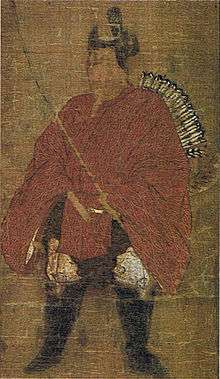Minamoto no Tameyoshi
| Minamoto no Tameyoshi | |
|---|---|
 Minamoto no Tameyoshi, from the collection of Shiramine Shrine | |
| Native name | 源為義 |
| Born | 1096 |
| Died | August 17, 1156 |
| Buried at | Gongen-ji, in Sujakuurahata-chō, Shimodagyō-ku, Kyōto |
| Battles/wars | Hōgen Rebellion |
Minamoto no Tameyoshi (源 為義, 1096 – August 17, 1156) was head of the Minamoto samurai clan during his lifetime, and grandson of Minamoto no Yoshiie; he led the Minamoto in the Hōgen Rebellion. Tameyoshi is also known as Mutsu Shirō (陸奥 四郎).
Though most famous for his involvement in the Hōgen Rebellion, Minamoto No Tameyoshi is also said to have intervened in a number of other conflicts earlier in his life. Around 1113, the ongoing rivalry between the warrior monks of Mii-dera and Enryaku-ji erupted into outright violence in the streets of Kyoto. Though the palace guard mobilized quickly to protect the Emperor, it is said that Tameyoshi, with a handful of mounted samurai, drove the mobs away himself.[1]
Upon being defeated in the Hōgen Rebellion, Tameyoshi took the tonsure and was released into the custody of his son Minamoto no Yoshitomo who then had him beheaded.[1]:256 This was an unprecedented breaking of Buddhist values in Japan, yet no one in the court berated Yoshitomo for his actions at the time until after his death.
See also
References
- trans. Varley, Paul H. (1980). "A Chronicle of Gods and Sovereigns 'Jinnō Shōtōki' of Kitabatake Chikafusa". New York: Columbia University Press.
